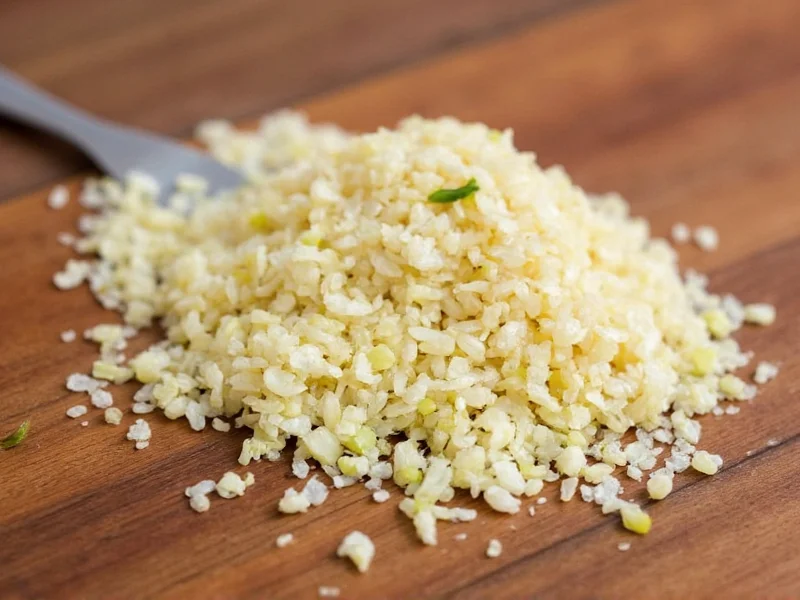When home cooks search for whats granulated garlic, they're seeking clear information about this common kitchen staple. Understanding the differences between various garlic forms can significantly impact recipe outcomes and flavor profiles in cooking.
What Exactly Is Granulated Garlic?
Granulated garlic consists of dehydrated garlic that's been processed into small, uniform granules. Unlike garlic powder, which has a fine, flour-like consistency, granulated garlic features coarser particles that retain more of garlic's natural oils and flavor compounds. The production process involves:
- Peeling fresh garlic cloves
- Dehydrating at low temperatures to preserve flavor
- Grinding to specific particle sizes (typically 0.3-1.0 mm)
- Screening to ensure consistent granule size
- Packaging in moisture-proof containers
Granulated Garlic vs. Other Garlic Forms
Understanding the differences between garlic products prevents recipe mishaps. Here's how granulated garlic compares to alternatives:
| Garlic Form | Texture | Flavor Intensity | Best Uses | Shelf Life |
|---|---|---|---|---|
| Granulated Garlic | Coarse granules (0.3-1.0 mm) | Moderate to strong | Dry rubs, spice blends, soups, stews | 2-3 years |
| Garlic Powder | Fine powder | Strongest | Sauces, dressings, baked goods | 3-4 years |
| Fresh Garlic | Whole cloves or minced | Freshest, most complex | Sautéing, roasting, raw applications | 1-2 months (whole) |
| Minced Garlic in Oil | Finely chopped | Moderate | Quick cooking applications | 18-24 months |
Flavor Profile and Culinary Applications
When considering what is granulated garlic used for, its unique properties make it ideal for specific cooking applications. The granules dissolve more slowly than powder but faster than fresh garlic, providing balanced flavor distribution. Chefs appreciate granulated garlic for:
- Dry spice rubs for meats where garlic powder might burn
- Long-simmering dishes like soups and stews
- Homemade seasoning blends where texture matters
- Situations requiring consistent garlic flavor without moisture
The flavor of granulated garlic sits between fresh and powdered forms—less intense than powder but more concentrated than fresh garlic. This makes it particularly valuable for granulated garlic substitution in recipes when fresh garlic isn't practical.
Substitution Guidelines for Home Cooks
Understanding how much granulated garlic equals one clove prevents over-seasoning. Use these ratios when converting between garlic forms:
- 1 fresh garlic clove = 1/8 teaspoon granulated garlic
- 1 teaspoon granulated garlic = 2-3 fresh cloves
- 1 teaspoon garlic powder = 1.5 teaspoons granulated garlic
- 1 tablespoon minced garlic = 1/2 teaspoon granulated garlic
When substituting, remember that granulated garlic needs time to rehydrate. For best results in cold applications like dressings, mix with a small amount of water first. In cooked dishes, add granulated garlic early enough to allow full flavor development—typically 10-15 minutes before dish completion.
Storage Recommendations for Maximum Freshness
Proper storage preserves granulated garlic shelf life and flavor. Follow these guidelines:
- Store in an airtight container away from light and moisture
- Keep in a cool, dark pantry (not above the stove)
- Never store in the refrigerator (causes clumping)
- Use within 2-3 years for optimal flavor
- Add a silica packet to prevent moisture absorption
Signs of degraded granulated garlic include clumping, darkening color, or diminished aroma. While not harmful, stale garlic won't deliver the robust flavor expected in your dishes.
Advantages Over Other Garlic Forms
Home cooks choosing between granulated garlic vs powder often select granules for specific advantages:
- Less likely to burn in high-heat cooking than powder
- Better texture in dry applications like rubs and coatings
- More consistent flavor release than fresh garlic
- No preparation time compared to peeling and mincing
- Longer shelf stability than fresh or jarred garlic
Professional chefs particularly value granulated garlic for commercial food production where consistent flavor and extended shelf life are critical factors.
Common Questions About Granulated Garlic
Understanding these frequently asked questions helps home cooks make informed decisions about using this versatile ingredient.
Frequently Asked Questions
What's the difference between granulated garlic and garlic powder?
Granulated garlic has coarser particles (0.3-1.0 mm) compared to the fine, flour-like consistency of garlic powder. Granulated garlic dissolves more slowly, provides a more balanced flavor release, and is less likely to burn in high-heat cooking applications. Garlic powder is more concentrated, with 1 teaspoon powder equaling about 1.5 teaspoons of granulated garlic.
Can I substitute granulated garlic for fresh garlic?
Yes, use 1/8 teaspoon granulated garlic per fresh garlic clove. For recipes requiring multiple cloves, multiply accordingly (e.g., 3 cloves = 3/8 teaspoon granulated garlic). Remember that granulated garlic needs time to rehydrate, so add it early in the cooking process for best flavor development.
Why does my granulated garlic clump together?
Clumping occurs when granulated garlic absorbs moisture from the air. To prevent this, store in an airtight container with a silica packet in a cool, dark pantry. Never store garlic products in the refrigerator where temperature fluctuations cause condensation. If clumping occurs, break up gently with a fork before use.
Is granulated garlic as healthy as fresh garlic?
While fresh garlic contains higher levels of allicin (the compound responsible for many health benefits), granulated garlic still retains significant nutritional value. The dehydration process preserves many beneficial compounds, though some heat-sensitive nutrients may be reduced. Both forms offer antioxidant properties and potential cardiovascular benefits.
How can I tell if my granulated garlic has gone bad?
Signs of spoiled granulated garlic include darkening color, strong bitter odor, or visible mold. Properly stored granulated garlic should maintain a light tan color and strong garlic aroma. If it has lost its characteristic smell or developed off odors, it's time to replace it, though expired garlic isn't typically harmful—just less flavorful.











 浙公网安备
33010002000092号
浙公网安备
33010002000092号 浙B2-20120091-4
浙B2-20120091-4